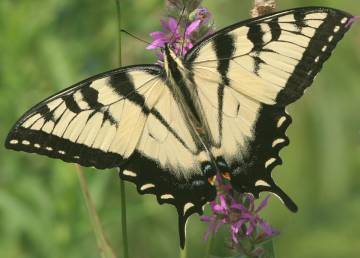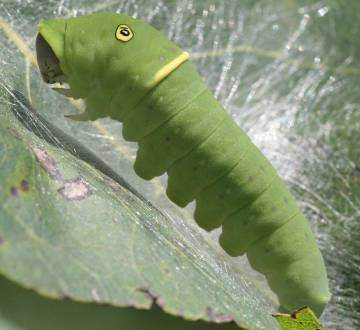

PHOTO COURTESY OF GARRY KESSLER
Tiger swallowtail butterflies are large, with a wing span of 3 to 4 inches, and common in our area. This tiger swallowtail is taking nectar from purple loosestrife, but these butterflies come to a variety of garden flowers and native wild flowers.
July 22, 2011, Page 4
NATURE NOTES
By Annie Reid
Westborough Community Land Trust
Tiger swallowtail butterflies
When someone says “butterfly,” what do you see in your mind?
Many people think “monarch” but actually picture a beautiful tiger swallowtail in their mind.
Tiger swallowtails are large yellow butterflies with black stripes. It’s quite apparent where the “tiger” in the name comes from. Like a whole group of butterflies, they’re called swallowtails because the “tails” on their hind wings remind people of the forked tails of certain swallows.
Monarchs, on the other hand, are orange and patterned with brown or black lines, as are the slightly smaller viceroys that look very much like monarchs.
July is the height of butterfly season and a great time to see tiger swallowtails, but you can see them from mid-April through October. A tiger swallowtail might be the first butterfly you notice in some years, although other butterflies, such as mourning cloaks and spring azures, are usually around even earlier.
Tiger swallowtails get an early start in the spring because they overwinter in the chrysalis stage. The chrysalis is a case that the full-grown butterfly caterpillar makes around itself as a place to change from caterpillar into butterfly. (In this way the chrysalis is similar to the cocoon that moth caterpillars make.) In butterflies that overwinter as a chrysalis, like the tiger swallowtail, this stage can include a long resting or dormant period that gets them through the winter.
When tiger swallowtails emerge from their chrysalises, one of the first things they do – especially if they’re male – is to head for a mud puddle. There they fill up on water and get minerals needed for reproduction. They suck water and dissolved minerals up through their long “tongue” or proboscis, which they also use to drink nectar.
In our area, we typically have two generations (or “broods”) of swallowtails during the spring and summer. For this reason, you might see a tiger swallowtail at a mud puddle any time, not just in the spring.
In Massachusetts we have more than one type of tiger swallowtail: Canadian tiger swallowtails (Papilio canadensis), eastern tiger swallowtails (Papilio glaucus), and some hybrids between the two. Both kinds look very similar and until 1991 were considered the same species. They have some subtle differences in markings that are hard for most of us to observe, even with close-focusing binoculars. Geneticists are working out the genetic differences.
As the name suggests, Canadian tiger swallowtails predominate to the north of us. They have only one brood (generation) each year, so a tiger swallowtail that you see in spring or early summer might be one of these.
Eastern tiger swallowtails are common to the south of us and typically have two broods each season. You might see one any time during the spring and summer, but especially in late summer or fall. The two kinds overlap in our area and sometimes breed together to produce hybrids, so it’s hard to know exactly which kind you’re looking at. In any case, enjoy!
Tiger swallowtails are fun to watch as they visit garden flowers or wild flowers for nectar, but you might also notice one fluttering from leaf to leaf, touching down briefly. It’s clearly not getting nectar, so what is it up to?

PHOTO COURTESY OF GARRY KESSLER
Look for mature tiger swallowtail caterpillars on the leaves of many different trees. This one is 1 and a half inches long and is resting on a thin nest of silk. One of a pair of eyespots is visible on the front part of the caterpillar. The eyespots give the caterpillar a face-like appearance that can startle an attacking bird. The caterpillar’s head is actually the black section that is tucked under the body at the left end of the caterpillar in this photo.
Most likely it’s a female searching for suitable places to lay eggs. It may even be laying eggs, one at a time on the right kind of leaf. Like other butterflies, tiger swallowtails have chemical sensors in their antennae and feet, so they can “smell” and “taste” with their feet (when they touch down). This is how they can tell when they’ve found the right plant for an egg.
What’s the right plant? Like other butterflies, they need to find a plant that will be the right food for the caterpillar that hatches from the egg. For tiger swallowtails, a variety of trees are suitable. Their caterpillar food plants include wild black cherry trees, tulip trees, magnolias, and ash trees for eastern tiger swallowtails, and aspens (poplars), birches, and willows for Canadian tiger swallowtails. With so many different trees serving as food plants for the caterpillars, it’s no surprise that tiger swallowtails are common in our area.
Tiger swallowtail eggs are tiny, round, and greenish. After about a week, a tiny caterpillar hatches. It’s dark with a white band around the middle. It eats what’s left of the egg and then starts munching the leaf.
As butterfly caterpillars eat and grow, they go through stages (called “instars”), shedding their skin and often changing their appearance somewhat as they pass from one stage to the next. In the first three stages, tiger swallowtail caterpillars are brown and white and look rather like bird droppings. They eat primarily at night and stay still during the day, all the better to mimic a bird dropping.
By the fifth stage, tiger swallowtail caterpillars are big enough that you – or a curious kid – might notice one on a leaf. At this stage, the caterpillar is green and smooth with two eyespots near the front. These eyespots are a bit of a disguise. They help to protect the caterpillar by scaring off an attacker, such as a bird, which might be startled by the “eyes” and snake-like appearance. If the caterpillar survives long enough to get to be about an inch and a half long, it’s ready to crawl onto the underside of a branch or stick and form a chrysalis.
Mimicry can be good protection for butterflies as well as their caterpillars. In some areas to the south of us (but rarely here), some eastern tiger swallowtail females are black, like another butterfly, the pipevine swallowtail (Battus philenor). If you visit places from Connecticut southward where pipevine swallowtails (and pipevines, their caterpillar food plants) are commonly found, you might see a black eastern tiger female, with tiger stripes that are even blacker. The more pipevine swallowtails there are in a particular area, the greater is the proportion of eastern tiger swallowtails females that are black.
What advantage would a butterfly get from looking like a pipevine swallowtail? Again, the answer is protection. The pipevines that pipevine swallowtail caterpillars eat contain chemicals that make both the caterpillar and the butterfly bad-tasting, so birds learn to avoid the black butterflies, including look-alikes. This isn’t all good for black tiger swallowtail females, however. It turns out that male tiger swallowtails may like yellow females somewhat better than black ones. As a result, there are usually more yellow eastern tiger swallowtail females than black ones. In our area, where pipevines and the butterfly caterpillars that feed on them are rare, so are the black tiger swallowtail females.
Keep your eyes open for tiger swallowtails near woodland edges, especially along fields or water. Don’t forget to look up – tiger swallowtails fly high among treetops in addition to fluttering among the wildflowers. They have adapted well to city parks, suburbs, and back yards, which have many edge environments and ornamental trees. Tiger swallowtails even breed in New York City’s Central Park.
Enjoy our tiger swallowtails for the rest of the summer, and be glad for all the trees in our woods that nourish their caterpillars.